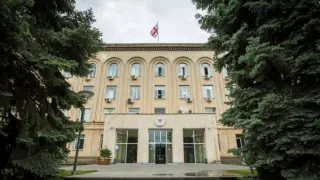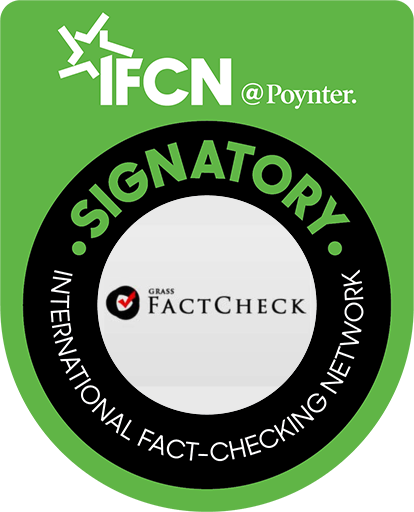Ministry of Environmental Protection and Agriculture of Georgia: “The value added in agriculture amounted to GEL 5 billion at current prices in 2024, which is GEL 110.8 million more than the previous year, according to preliminary data.”
Verdict: FactCheck concludes that the Ministry of the Environmental Protection and Agriculture’s statement is MOSTLY TRUE.
The growth in agriculture, forestry and fisheries (i.e., the value added created in agriculture) amounted to USD 4,976.6 million at current prices, which is GEL 110.9 million higher than the figure recorded in the previous year (GEL 4,865.7 million), according to preliminary data for 2024. Accordingly, the information published by the Ministry is accurate.
However, the aforementioned figure is not a relevant indicator for assessing progress in agriculture, as using a nominal indicator for analysis over time can be considered a manipulation.
It is important to analyse, on the one hand, the real growth rate and, on the other hand, the share agriculture holds in the country’s overall economy (that is, its share in gross domestic product) to properly assess the progress in agriculture. The real growth in agriculture, which reflects the change in production volume as compared to the previous year, shows how the sector’s output has changed without the effect of price fluctuations.
Agriculture grew by 4.4% according to preliminary data for 2024. Notably, the sector had been experiencing a decline in previous years.
As for the share of agriculture in the GDP, it constituted 6.9% in 2023, reflecting a decrease of 0.7 of a percentage point as compared to the previous year. The share of agriculture in the GDP has been decreasing since 2021, indicating that other sectors of the economy have been growing at a faster rate than agriculture.
Considering the accuracy of the cited data, but the use of irrelevant figures to showcase progress, alongside the fact that agriculture has grown this year but its share in the GDP has decreased, FactCheck concludes that the Ministry’s statement is MOSTLY TRUE.
Analysis
The Ministry of Environmental Protection and Agriculture posted a card on their Facebook page claiming: “The value added in agriculture amounted to GEL 5 billion at current prices in 2024, which is GEL 110.8 million more than the previous year, according to preliminary data.”
FactCheck investigated the aforementioned trends.
Preliminary data for 2024 shows that the growth in agriculture, forestry and fisheries (i.e., the value added created in agriculture) amounted to USD 4,976.6 million at current prices, which is GEL 110.9 million higher than the figure recorded in the previous year (GEL 4,865.7 million), according to the information provided by GeoStat. Accordingly, the information published by the Ministry is accurate.
However, whilst the Ministry cites the aforementioned data to illustrate success in the sector, it is important to note that these figures are not relevant for assessing the true progress in agriculture, as using a nominal indicator for analysis over time is misleading.
It is appropriate to analyse both the real growth rate and the share of agriculture in the country’s overall economy (that is, its share in the GDP) to assess progress in the sector.
The real growth in agriculture, which reflects the change in production volume as compared to the previous year, shows how the sector’s output has changed without the effect of price fluctuations. Thus, it is necessary to compare the real added value created in the sector with that of the previous year to accurately present the progress. This method excludes the increase in value caused by prices changes (inflation).
The real growth of agriculture (including forestry and fisheries) reached 4.4% in 2024, following previous decreases of 3.4% in 2023 and 1.8% in 2022, according to GeoStat. Notably, the sector recorded a 2.3% growth in 2021.
Looking at the statistics from recent years, the real growth of agriculture was 10.7% in 2011, whilst 2012 saw a 3.5% decline. The highest real growth rates were recorded in 2013 and 2018, reaching 15.7% and 13.8%, respectively. The sector experienced periods of decline in 2014, 2016 and 2017, consequently reaching a peak in 2018, as mentioned above. The growth trajectory continued into 2019, 2020 and 2021, but the sector once again experienced a decrease in 2022 and 2023.
Regarding the share of agriculture in the gross domestic product, it constituted 6.9% in 2023 (results for 2024 are yet to be announced). This figure was 7.6% in 2022 and 8.3% in 2021. The sector experienced a declining trend from 2015 to 2017 following a notable growth in 2013-2014. The share of agriculture in GDP has shown no clear pattern in the subsequent years, sometimes increasing and sometimes decreasing. However, a decline has been noted since 2021, indicating that other sectors of the economy have been growing at a faster pace than agriculture.
Graph 1: Real Agricultural Growth and Its Share in GDP
Source: National Statistics Office of Georgia
As mentioned above, whilst the data published by the Ministry of Agriculture is accurate, sufficient evidence was not provided to confirm the progress claimed in the sector. Thus, FactCheck concludes that the Ministry’s statement is MOSTLY TRUE.








